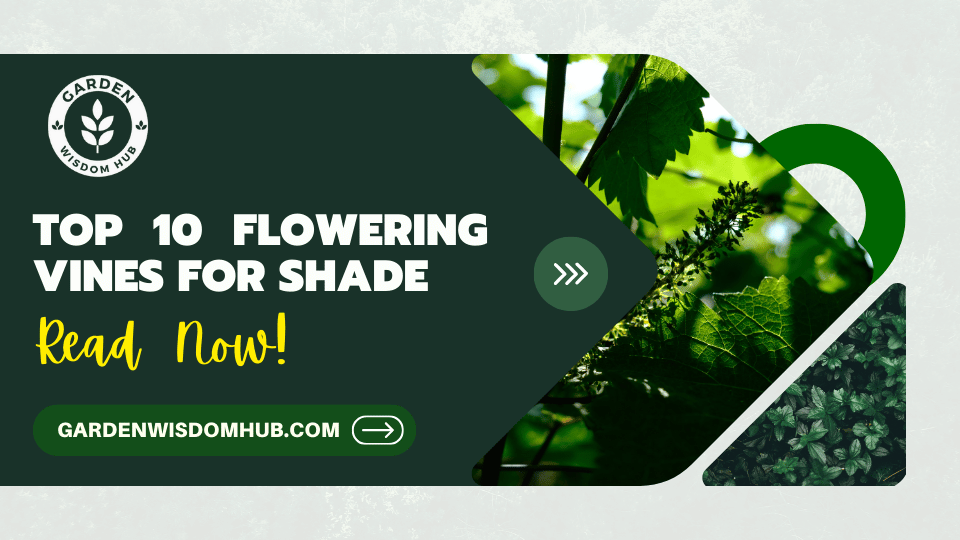Flowering climbing vines for shade
Finding the Evergreen flowering vines for shade for your garden can be like finding a needle in a haystack, but there are lots of climbing flowering vines for shade. These plants can suit those poorly lit corners.
They will provide colour and charm to your life, and knowing their soil, water, fertiliser, pruning, and humidity demands will keep them healthy all year! Let’s explore 10 great climbing vines with flowers for shade.
This article digs deep into shade-loving flowering vines and their maintenance advice to make your garden bloom like a daisy. Some of them are best flowering vines for partial shade
1- Clematis (spp.)
Clematis is the queen of flowers with her breathtaking pink, purple, white, and blue blooms. Some varieties, like Clematis alpina, thrive in partial shade.
Soil:
A well-drained, neutral patch of dirt with a little of acidity to keep things fresh!
Watering:
Regularly water your roots to keep them cool and moist.
Fertilizer:
In spring, feed it a balanced, slow-release fertiliser and watch it bloom like a daisy!
Pruning:
After the flowers have bloomed, prune it to encourage new growth like daisies!
Humidity:
It can take some humidity, but needs a breeze to avoid sauna-like conditions!
2- Climbing Hydrangea (Hydrangea anomala subsp. petiolaris)
Climbing Hydrangea is perfect for gloomy spots with huge bunches of white blossoms and a thick, leafy look!
Soil:
Fish-damp, sieve-drained, and full of organic deliciousness.
Water:
Keep that soil moist as a sponge, especially when the sun is hot like a skillet.
Fertilizer:
Feed your plants a balanced fertiliser in early spring and mid-summer to see them bloom like daisies!
Pruning:
A few snips here and there; clean away the deadwood when the blooms have finished. Loves a steam bath, but needs a wind to avoid mould.
3- Virginia Creeper (Parthenocissus quinquefolia)
Although known for its foliage, Virginia Creeper gives spectacular fall colour to shady gardens. It can manage a varied bag of soils, even those as tough as nails and compact as tin cans.
Water requirements:
This plant is as easy going as a Sunday morning, it doesn’t need much to drink and can survive a dry period once bedded in.
Fertiliser:
This plant is low-maintenance and just needs a sprinkle of fertiliser, but a slow-release boost in spring can be like icing on the cake! It can control size by pruning in late winter or early spring. It does well in high and low humidity.
4. Honeysuckle (Lonicera spp.)
Shadier gardens benefit from aromatic honeysuckle types like Lonicera periclymenum. Fertile, well-drained soil. Honeysuckle for shade is a good option.
Water requirements :
Water it occasionally to keep the soil happy! Use a balanced fertiliser in spring and summertime to boost your plants.
Pruning:
A bit of pruning after the blooms have had their day in the sun keeps them looking sharp.
Humidity:
A little humidity goes a long way, but too much can turn your room into a mildew mansion. Keep the air flowing, and you’ll be OK!
5: Ivy-leaved Toadflax (Cymbalaria muralis)
It is the plant world’s wallflower! This small green guy climbs social ladders by adhering to walls like a cat to a sunny place. More charming than a barrel of monkeys and tough as nails, it’s the life of the garden party! Who knew a plant could be so? Toadflax, a charming vine, has small violet blossoms perfect for filling cracks and gaps. Like adding a cherry on a sundae!
Soil:
Well-drained, neutral like Switzerland, with a little alkalinity to keep things active! It needs water regularly, but once it’s settled in, it can survive dry spells.
Fertiliser:
A sprinkle of compost mulch once a year is enough, just like a cat needs a bath! Pruning: It seeds like amazing without your help!
Humidity:
It can handle bone-dry to soup-like situations without a sweat.
6. English ivy (Hedera helix)
English Ivy thrives in the shadows like the dance wallflower in its luscious green gown. This evergreen vine can keep its cool in low light and make any shaded place feel at home!
Soil:
It can tolerate a variety of soil types, but thrives in wet, well-drained soil that tickles its roots. A small sprinkle can protect that soil from becoming a desert, so keep the watering can accessible!
Fertilizer:
In spring and summer, feed it a balanced fertiliser and watch it thrive like a fish in water!
Pruning:
Trim hedges as needed to maintain shape.
Humidity:
It dances in humid and dry conditions, but prefers moderate humidity.
7. Triumph Vine (Campsis radicans)
It is a garden showpiece as bold as brass! Trumpet vine brightens up shaded areas like a firecracker on July 4 with its large, dramatic blossoms!
- Soil: A well-drained, fertile area that can handle some roughness.
- Water: It drinks water, but don’t drown it! Let the dirt rest between sips.
Fertilizer:
A sprinkle of compost in spring works wonders, but don’t overdo it—just a pinch! Prune the hedges in late winter to control wild growth before it gets out of control! It can handle high humidity, but prefers moderate to low humidity.
8. Sweet Autumn Clematis (Clematis terniflora)
In late summer, this clematis variety blossoms fragrant, star-shaped flowers, making it the perfect choice for partially shaded gardens that need a little extra excitement.
Soil:
Well-drained, organically rich soil. Maintain soil happiness like a clam, but don’t drown it like a fish.
Fertilizer:
Feed it balanced fertiliser in early spring and watch it flourish like a flower in the sun! In late winter, prune old timber to give fresh sprouts a fighting chance!
Humidity:
Keeps things comfortable with just enough moisture and a breeze to avoid fungal issues.
9. Passionflower (Passiflora caerulea)
It is a yard showpiece, this beauty is as delightful as a cat in a rocking chair room! Its complex blossoms look like nature invited all the colours to a party. Not all is rainbows and sunshine—this plant can be a diva and needs just Passionflower is a unique vine with stunning blossoms! It can withstand some shadow, but it glows like a kid in a candy store when the sun peeps through!
Soil:
A well-drained, fertile area rich in organic matter. Drink it to keep the soil happy as a clam, but don’t drown it like a fish in a barrel!
Fertilizer:
Feed your plants a balanced fertiliser regularly during the growing season and watch them bloom like flowers in the sun!
Humidity:
This plant soaks up moisture like a sponge, so misting it when the air is bone dry works wonders!
10. Dutchman’s Pipe (Aristolochia macrophylla)
Dutchman’s Pipe is a brave vine with leaves that may rival a tree! Its dense greenery and pipe-shaped flowers make it ideal for shaded areas.
Croesus-rich, sieve-drained soil! Maintain sponge-like soil moisture, especially when the sun is scorching as a poker.
Spring fertiliser:
When the flowers bloom and the birds sing, give your plants a boost! Trimming the hedges after the blossoms have finished helps them grow like weeds! In shady corners, humidity keeps it comfortable.
Finishing Up: Flowering Vines for Shade
Dark garden nooks don’t have to be like a wet day! With a little imagination, you may change that melancholy into a brilliant sanctuary the sun will envy! Add some sunshine, sweetness, and colour to even the gloomiest corners with these 10 flowering vines for shade.
By learning each plant’s soil, water, fertiliser, pruning, and humidity demands, you may create a paradise garden! For more details, read our other articles:
Study these flowering vines for shade. There’s a vine for every shaded garden nook, from trumpet vine to passionflower. Wishing you springtime weeds and well-watered flowers! Happy digging!
James Porter
Welcome to our haven of gardening and plant care, where outdoor and indoor planting enthusiasts come together! At Gardening Wisdom Hub, we aim to provide you with the most authentic information on anything related to gardening, plant care, seasonal planting etc.
The author of our website is James Porter, an experienced industry veteran. He has a deep interest in everything green. James’s enthusiasm for exploring plants’ features and learning new gardening methods began at a young age. Gradually, his passion increased with time, leading him to become a highly esteemed professional. His extensive knowledge makes him a priceless resource for inexperienced and seasoned gardeners.

